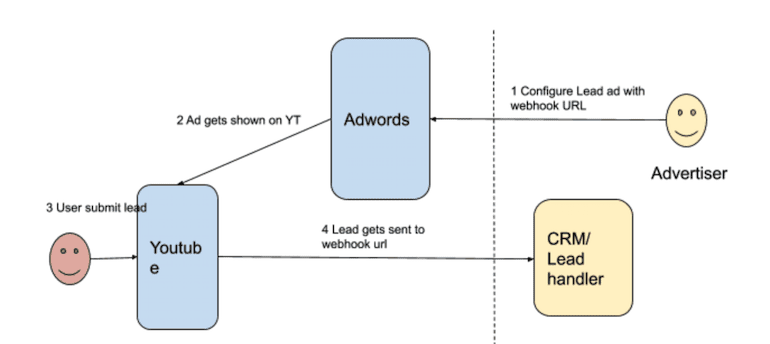Hello PPC nerds & nerdettes!
In this post, I will be talking about YouTube strategy, but more specifically, I will be talking about turning prospects into customers with TrueView for Action Lead Form Ads. I’ll cover what you need to know about YouTube Lead Form Ads before you start putting forth time and energy into an endeavor such as this.
Before I begin, if you’re looking for a more general, “I’m just getting started on YouTube” YouTube strategy/best practices article, I suggest this article: Creating a Robust YouTube Ad Strategy.
For some time now, YouTube has been becoming more and more popular with advertisers. From using YouTube to generate brand awareness to using the new Lead Form Ads to drive actual leads/conversions, Google has been working to build YouTube into an advertising channel that appeals to all types of businesses and advertisers.
Whether you’re searching for leads, website traffic, product and brand consideration, or brand awareness and reach, YouTube has a campaign/ad-type type for you! To list them, we have skippable in-stream, bumpers, non-skippable in-stream, outstream, discovery, ad sequence, and TrueView for Action campaigns.
This effort from Google to expand YouTube is hardly surprising, considering the nearly 2 billion monthly logged in users on YouTube, as reported by Google. With YouTube’s unlimited inventory, the opportunities for advertisers is nearly limitless, provided Google can provide a form of advertising on YouTube that appeals to everyone, which is where the new YouTube for Action Lead Form Ads come into play.

YouTube for Action Form Ads
One of Google’s most recent YouTube expansions came in the form of YouTube for Action. YouTube for Action, allegedly, allows us to reach our audiences using intent signals on YouTube, a platform which is becoming more and more essential to consumer purchase decisions. More importantly, YouTube now allows us to drive conversions with new ad formats optimized for action, such as the Lead Form Ads.
YouTube Lead Form Ads drive leads via in-line form submissions, meaning the user no longer has to navigate off of YouTube in order to complete a form fill. This is a huge step in the right direction for making YouTube a more lead gen friendly platform. That said, users still have the option to navigate to your site after completing a form fill should they be interested in doing so.
The Lead Form Ads are something you currently need to be whitelisted by Google for, in order to be able to use, but it’s something we’ve been able to begin testing here at Hanapin.
What to Watch Out for Before Starting
Let me be the first to tell you that creating YouTube for Action campaigns with Lead Form Ads can be a time-intensive process to get set up and configured correctly. I would love to let you all learn from some of our early blunders with the Form Ads!
To start, I’ll speak to the information you’re currently able to ask users for via the in-line submissions. Google currently allows for little customization when it comes to what information your form can ask for. Currently, all the information you can gather is the user’s name (first and last name), email, phone number, and zip code. If you need any more info than that in order to qualify a lead, then I wouldn’t suggest moving forward with YouTube Form Ads, for the time being, as those are the only pieces of information we can gather.
Next, I’ll speak about where the data that’s fed into the lead form goes. The default option is that the leads will be stored within the Google interface, for up to 30 days, where you can pull the data whenever you want. This is likely a much more manual process for pulling leads than most of us are used to, as I imagine most of us use some kind of CRM software.
Google, like myself, also imagined that many of us are using CRM software and has created a type of webhook workaround to the default option of manually pulling the Form Ad leads.
Google’s webhook solution API aims to provide advertisers the capability to feed leads in near real time to their CRM of choice. There are some already built out webhook solutions, like with Salesforce, for example, however, should the CRM you use not already have a webhook built out, then you’ll have to work with your CRM provider to build one. This can be one of the more time-intensive parts of the entire Lead Form Ads set-up process.
If you know/find out that there isn’t a prebuilt webhook solution for the CRM software you use, you should budget an extra month or more into the launch time unless your CRM provider has nothing to do except focus on building the webhook.

The last thing I would urge you to keep in mind when planning a build for these new Lead Form Ads is the fact that you cannot copy/paste the lead form ads across campaigns, and you cannot add them to pre-existing campaigns. This means that if you wanted to create 100 new YouTube for Action campaigns with Lead Form Ads you would have to create each individual campaign one at a time. Each time you would have to re-write the ad copy for the Lead Form Ad and each time you would have to layer in the video asset, among a few other steps. You can see how tedious this might get and if you didn’t budget time for such an intensive build out you might easily become behind schedule.
I think my final piece of advice when working through setting up Lead Form Ads for the first time is simply to expect the unexpected, as cliche as that sounds. It took us much longer than originally anticipated to get our YouTube for Action campaigns with Lead Form Ads up and running.
Conclusion
In conclusion, YouTube for Action Lead Form Ads is, in my opinion, the “next big thing” to come to YouTube, as YouTube has traditionally never been friendly for the lead gen advertiser. Overall, I think there are still plenty of kinks that Google is trying to work out while these are still in beta/whitelist status so I would expect some of what I just wrote to be irrelevant here in the near future, however, I hope I can save some lucky souls from the same fate we experienced while going the set-up for the very first time.
If this is something that interests you, I would highly recommend attempting to get whitelisted to test Lead Form Ads. The more input Google gets from us, the advertiser, the better this product can become in the future!




